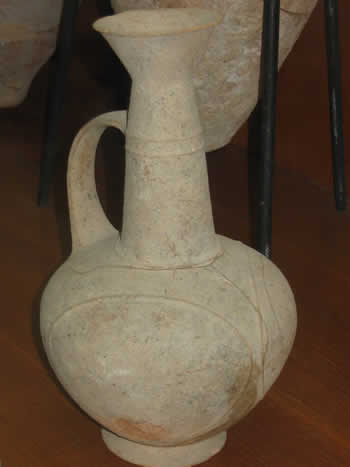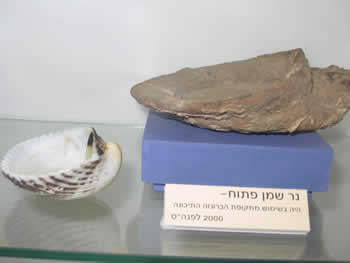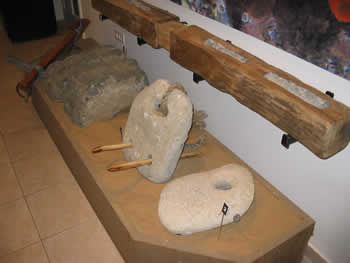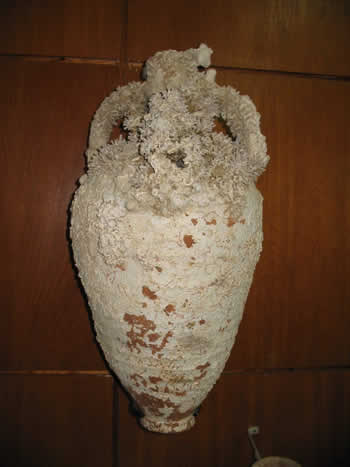Search our Archives:
» Home
» History
» Holidays
» Humor
» Places
» Thought
» Opinion & Society
» Writings
» Customs
» Misc.
|
Yavneh Yam
By Jacqueline Schaalje
Yavne, located on the Mediterranean coast 20 kilometers south of Jaffa and the same distance to the north of Ashdod, was known mainly as the center of learning of Jewish rabbis after the destruction of the Temple of Jerusalem by the Romans in 70 CE. There is also a tradition which claims that Yavneh was the burial place of the Biblical Reuven. Yavneh Yam, although little known, is important for understanding shipping practices in the ancient world. Last but not least, it is the location of the find of an important inscription which demonstrates the relations of the citizens with the Seleucid King Antiochus V.
Like some other coastal towns, Yavneh had an inland settlement and a counterpart on the sea about 8 kilometers to the northwest, which was Yavneh Yam. As the modern town of Yavneh covers the same place as historical Yavneh, archeological research has concentrated on the ancient coastal tel. The digs are fairly recent and are by no means finished, therefore the site has not yet been turned into a national park.

Decanter Found in Sea at Yavneh Yam
According to archeological finds on the location, Yavne Yam was first settled about 3000 years ago. However, the historical evidence dates from much later. While the inland Yavneh is the biblical place which King Uziah defended successfully against the Philistines, after reinforcing its fortifications (II Chronicles 26: 6), the history of Yavneh Yam is somewhat shadier. Although there is mention of a place that is simply called "harbor" in the Egyptian El Amarna letters which have a list of Israeli cities that have been subdued by the Pharaoh (14th century BCE), which could refer to the port of Yavneh, the first sources that mention the name Yavneh Yam or its alternative Greek name of Yamnia, are from the early classical Age. In Medieval times, Yavneh was internationally known, and several sources call it the Jewish Port.
What type of people lived there is also somewhat unclear. It seems that the port was initially inhabited by Phoenicians, who were conquered by the Babylonians, then by the Persians, and subsequently by Alexander the Great. During the Greek period our story picks up because of an important inscription which has been found in Yavneh Yam that shines light on the history of the town. It contains two letters, written in Greek, which form a correspondence between the citizens of Yavneh Yam with the Greek King Antiochus V Eupator (164-162 BCE; he was the son of the cruel Antiochus IV, the one who by deceitful means tried to Hellenize the inhabitants of Palestine and inspired the Maccabean revolt). Antiochus V, by contrast, was a mild king, without much influence, but he could hardly have made an impact in the two years that he ruled until his throne was usurped by his cousin Demetrius I.
In any case, the correspondence is interesting because it indicates that Antiochus tried to accommodate his subjects, and his subjects tried by way of rendering services or by merely paying lip service to extract special favors. The first letter is a petition to King Antiochus from the Sidonians in the Port of Yavneh Yam: "Since [their ancestors] rendered many services to his grandfather, promptly obeying [all] instructions regarding the naval service..." The "grandfather" is presumably Antiochus III, whom the city would have helped during his war against the Ptolemy Empire in Egypt.

The Famous Greek Incription Between Antiochus and Citizens of Yavneh Yam
The second letter is by the King who writes to one particular citizen of Yavneh Yam, called Nessos; maybe he was the writer of the petition, or he was the representative of the city. It states: "[King An]tiochus to Nessos, greetings. The recorded petition was submitted by [the Sid]onians [in Yavneh Yam]. Since...the...referred to are [also] immune...so that they will also enjoy the same privileges. Farewell. Loos 149." Loos is the name of the month and 149 the year according to the Greek calendar. The "Sidonians" are the Hellenized citizens of Yavneh Yam.
However, whether the citizens had really become loyal Greeks or were just pretending: it failed to charm the Maccabees, who thought there was too much worshipping of idol gods in Yavneh Yam (as well as in other cities that they set out to cleanse). In the second Book of the Maccabees we read: "Judas Maccabaeus fell upon the Jamnites [people of Yavneh-Yam], too, by night and set fire to the fort and the ships, so that the glare of the flames was visible as far as Jerusalem, two hundred forty stadia away (12: 9, 39-46)." Although the authenticity of the Books of the Maccabees is not undisputed, the destruction of the city is real; but in fact it was left to the Hasmonean rulers John Hyrcanus (135-105 BCE) and Alexander Jannaeus (103-76 BCE) to finally destroy it, several decades after the Maccabean revolution.

Ancient Oil Lamp at Yavneh Yam
During the Roman era nearby Yavneh became an independent city and the Emperor Augustus gave Yavneh to Herod . Again, not much is heard about Yavneh Yam until the Byzantine empress Eudocia settled down in the Holy Land around the mid-5th century CE and built her estate on the coast. Yavneh was also contested between the Moslems and the Christian Crusaders, but what the role of the Moslem fort was in Yavneh Yam is unclear. The site was abandoned somewhere around the 12th century, for unknown reasons.

Fishing Net Weights Found in Sea at Yavneh Yam
What we know is that throughout its existence, Yavneh Yam served mainly as a fishing settlement and it was the main trading port between Sinai and Jaffa. It had a natural harbor, of kurkar reefs, and because of its location on a promontory, it is protected by a bay on the south side as well as on the north side. Many of the archeological data about Yavneh Yam originate from shipwrecks that stranded on the coast and that have been recovered by underwater archeologists (divers): as the Mediterranean waters were known for its tricky currents and sudden storms, ships used to "embrace" the coast as they sailed from harbor to harbor, which explains why there were so many harbors; but through this they increased the risk to wreck themselves on the rocks.
The finds produce ample evidence of a flourishing trade. There are not only ship accoutrements, like wooden and stone anchors (although the wood elements were mainly eaten by the sea), fishing equipment like hooks, sounding leads and net weights, but also equipment that was used on board such as a stove that could be used for cooking but also for melting of gold or other metal so that the sailors could produce some handiwork during the long boring journeys; there were grinding stones, cooking pots and bowls, storage jars and amphorae which were used for exporting wine and oil from Israel to destinations all over the Mediterranean. The ships were either built locally or foreign.
Visit
The site can be visited (via the road from Kibbutz Palmachim road no. 4311) and the finds that have been uncovered are on display in the Beit Miriam museum at kibbutz Palmachim (phone in advance to make an appointment; a guide from the museum can take you to the archeological sites). The museum's main asset is the original Greek Antiochus inscription. The initial finds and also the sorting of the pottery shards etc. were done by kibbutz members.
The oldest layers that have been uncovered on the tel date to the Bronze Age. The buildings of this period are made of mud bricks and there is simple white pottery. There is also an impressive gold treasure, consisting of beads, earrings, (parts of) jewelry, and a seal that hails from Syria. The artifacts were found in an area where two figurines of the god Ba´al were found as well, together with bronze weaponry, like spearheads and arrows and axes, pointing towards some cult whereby valuable objects were offered to the god.

Old Anchors Found in Sea at Yavneh Yam
The remains of the Iron Age show that Yavneh Yam, despite its small size, was fortified by a 2 meter thick wall, which protected the settlement all through the 10th to the 7th centuries BCE. There was also a monumental building built in the sophisticated Phoenician header and stretcher method, from ashlars hewn out of kurkar rock and with mud bricks on top, which recalls some of the top archeological sites in Israel, e.g. the "king cities" where the Israelite kings resided, like Dan and Hathor etc. As for now, we do not know which important persons resided in Yavneh or what the function was of this building; maybe it was simply the office of some harbor authority.
Inside the building, locally produced as well as imported Greek pottery was unearthed. In addition, there are the usual Egyptian imported scarabs which are found in many sites in Israel, and stone weights with a Hebrew inscription, "pym": this was part of a shekel. At some point the civilization that built this building was conquered but it is as yet unknown by whom: it could be during the Egyptian campaign of Pharaoh Necho in 609 BCE, or by the Babylonians who instigated several military expeditions before they succeeded in subduing all of the Israeli cities: it could be in the earlier expeditions around 620 or in 604 BCE during which nearby Ashkelon was also destroyed.
During the Persian occupation Phoenician building techniques were kept in use, but gaps between the stones were filled with fieldstones. Huge collections of pottery were found, imported as well as local. There are also some (fragments of) terracotta statuettes of Greek gods and Phoenician coins, witnessing to trade with these nations.
The remains from the Greek period are heavily damaged, because of the destruction that the campaign of John Hyrcanus wrought. The museum has a small heap of nails on display which are thought to have come from the boots of Greek soldiers: Jews apparently did not wear boots. The Greek conquerors were not great builders. They reused the old buildings and plastered them in yellow, red and white, and they also added some classical embellishing features. Again there are large quantities of pottery remains, among which imported amphorae which have inscribed handles: one handle showed where they were made and the other indicated for whom the locally produced wine and oil was destined.
There are also murex shells, which contained the sea snails from which the Phoenicians produced a purple dye which was in wide demand in the ancient world. This is interesting, as it could indicate that there were still Phoenicians who lived in Yavneh or alternatively that the technique of extracting the dye had been taken over by the locals.
In the Roman period we can first witness how Judaism has influenced daily life: there are four typically Jewish ossuaries of limestone. There are also remains of villas, lots of oil lamps, and Hasmonean coins that, in contrast to coins from other periods which often bear the portrait of the ruler, carry Jewish symbols.
The Byzantine period was one of prosperity with the influx of pilgrims to Israel. The citizens of Yavneh Yam built a church, but otherwise Jewish and Christian inhabitants lived in peaceful coexistence. One historical source relates a story about a Jewish fisherman, and there is an oil lamp with a menorah decoration. By the way, the museum has numerous oil lamps on display and not only from the later eras; the oldest date from the Bronze Age and they show how similar their form is to a common shell which are found on the beach. In later periods the lamps were closed, except for a round hole where the oil was poured into, and the outside was decorated, but otherwise the basic shape stayed the same.
The private houses during the Byzantine period are more elaborate. Several intricate mosaic have come to the surface. The citizens chilled out in an extensive bath complex with plastered walls and floor mosaics; it is divided into a central pool which was round like a cistern and which filled with rain water, this was then pumped to four adjacent square pools through lead pipes. There are other clues that the city prospered: the eastern part of the tel held a funerary cave cut out in the rock that was decorated with frescoes of red medallions and there are numerous pithoi or large pottery bowls of at least a meter in diameter for storage of grain and other food stuffs, which indicate the logistics of a large community.
After Yavneh Yam was conquered by the Muslims, a fort was built on the coast, of which the tower has been excavated to a height of 5 meters. It was called Fort Rubin, as the Moslims also have the tradition of the burial place of Reuven, and it may have served as a prison. One column is inscribed by Arabic graffiti of the 7th century, on which the term shahada (martyrdom) appears, although it is unknown to what conflict it refers. There are also colorful pottery, glass weights and coins from this period.
~~~~~~~
from the January 2006 Edition of the Jewish Magazine
|
|











